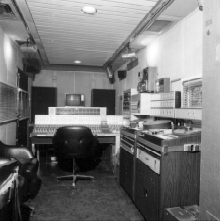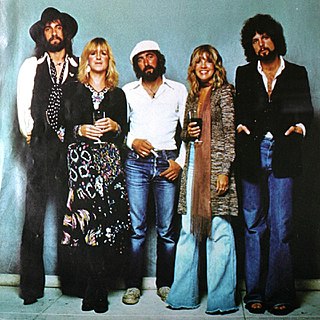
Fleetwood Mac are a British-American rock band formed in London in 1967 by guitarist and singer Peter Green. Green recruited drummer Mick Fleetwood, guitarist and singer Jeremy Spencer and bassist Bob Brunning, with John McVie replacing Brunning a few weeks after their first public appearance. Guitarist and singer Danny Kirwan joined the band in 1968. Christine Perfect, who contributed as a session musician starting with the band's second album, married McVie and joined Fleetwood Mac as an official member in July 1970 on vocals and keyboards, two months after Green left the band; she became known as Christine McVie.

The Rolling Stones are an English rock band formed in London in 1962. Active across seven decades, they are one of the most popular and enduring bands of the rock era. In the early 1960s, the band pioneered the gritty, rhythmically driven sound that came to define hard rock. Their first stable line-up consisted of vocalist Mick Jagger, guitarist Keith Richards, multi-instrumentalist Brian Jones, bassist Bill Wyman, and drummer Charlie Watts. During their early years, Jones was the primary leader of the band. After Andrew Loog Oldham became the group's manager in 1963, he encouraged them to write their own songs. The Jagger–Richards partnership became the band's primary songwriting and creative force.
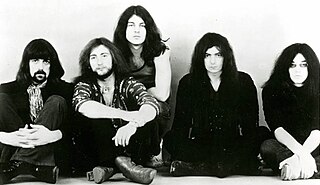
Deep Purple are an English rock band formed in London in 1968. They are considered to be among the pioneers of heavy metal and modern hard rock, although their musical style has varied throughout their career. Originally formed as a psychedelic rock and progressive rock band, they shifted to a heavier sound with their 1970 album Deep Purple in Rock. Deep Purple, together with Led Zeppelin and Black Sabbath, have been referred to as the "unholy trinity of British hard rock and heavy metal in the early to mid-seventies". They were listed in the 1975 Guinness Book of World Records as "the globe's loudest band" for a 1972 concert at London's Rainbow Theatre and have sold over 100 million albums worldwide.
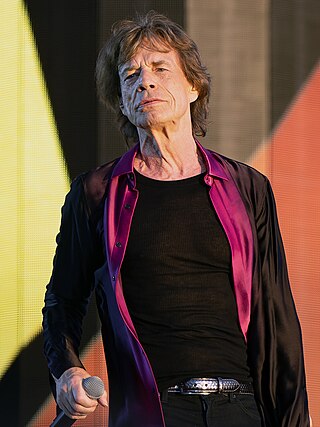
Sir Michael Philip Jagger is an English singer. He is the front man and one of the founder members of the rock band the Rolling Stones. Jagger has written most of the band's songs alongside lead guitarist Keith Richards; their songwriting partnership is one of the most successful in history, and they continue to collaborate musically. His career has spanned over six decades, and he has been widely described as one of the most popular and influential front men in the history of rock music. His distinctive voice and energetic live performances, along with Richards' guitar style, have been the Rolling Stones' trademark throughout the band's career. Jagger gained notoriety for his romantic involvements and illicit drug use, and has often been portrayed as a countercultural figure.

Terrance James Reid, nicknamed "Superlungs", is an English rock vocalist, songwriter, and guitarist best known for his emotive style of singing in appearances with high-profile musicians as vocalist, supporting act and session musician. As a solo recording and touring artist, he has released six studio albums and four live albums. His songs have been recorded by numerous artists including The Hollies, Crosby, Stills & Nash, Arrival, Marianne Faithfull, Cheap Trick, Jack White with The Raconteurs, Joe Perry, Rumer and Chris Cornell.
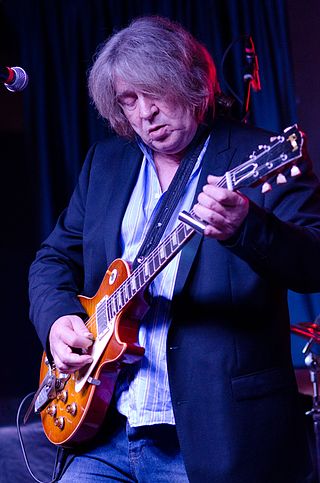
Michael Kevin Taylor is an English guitarist, best known as a former member of John Mayall's Bluesbreakers (1967–1969) and the Rolling Stones (1969–1974). As a member of the Stones, he appeared on Let It Bleed (1969), Get Yer Ya-Ya's Out! The Rolling Stones in Concert (1970), Sticky Fingers (1971), Exile on Main St. (1972), Goats Head Soup (1973) and It's Only Rock 'n Roll (1974).

Jamming with Edward! is a 1972 album by three Rolling Stones band members accompanied by Nicky Hopkins and Ry Cooder.

Rolling Stones Records was the record label formed by the Rolling Stones members Mick Jagger, Keith Richards, Mick Taylor, Charlie Watts, and Bill Wyman in 1970, after their recording contract with Decca Records expired. The label was initially headed by Marshall Chess, the son of Chess Records founder Leonard Chess. It was first distributed in the United States by Atlantic Records subsidiary Atco Records. On April 1, 1971, the band signed a distribution deal for five albums with Ahmet Ertegun, acting on behalf of Atlantic Records. In the US, the albums were distributed by Atlantic until 1984. In the UK, Rolling Stones Records were distributed by WEA from 1971 to 1977 and by EMI from 1978 to 1984. In 1986, Columbia Records started distributing it in the United States and CBS for the rest of the world until 1991. It was discontinued in 1992 when the band signed to Virgin Records, but the tongue and lips logo remains on all post-1970 Rolling Stones releases.
Stephen Davis is an American music journalist.

Stargroves is a manor house and associated estate at East Woodhay in the English county of Hampshire. The house belonged to Mick Jagger during the 1970s and was a recording venue for the Rolling Stones and various other rock bands, as well as a filming location for Doctor Who.
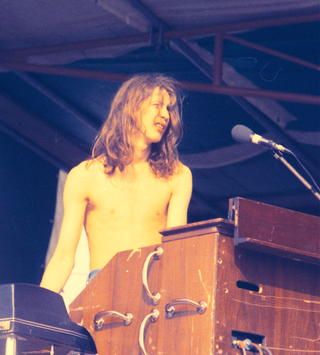
John Douglas "Rabbit" Bundrick is an American keyboardist. He is best known for his work with the rock band the Who and associations with others including Eric Burdon, Bob Marley and the Wailers, Roger Waters, Free and Crawler. Bundrick is noted as the principal musician for the cult film The Rocky Horror Picture Show. In the mid-1970s, he was a member of the short-lived group Mallard, formed by ex-members of Captain Beefheart's Magic Band. He is also known as a composer and has recorded solo albums. He was also a member of the Texas group Blackwell, who had a hit single in 1969 entitled "Wonderful".

The Record Plant is a recording studio established in New York City in 1968 and currently operating in Los Angeles, California. Known for innovations in the recording artists' workspace, it has produced highly influential albums, including the New York Dolls' New York Dolls, Bruce Springsteen's Born To Run, Blondie's Parallel Lines, Metallica's Load and Reload, the Eagles' Hotel California, Fleetwood Mac's Rumours, Eminem's The Marshall Mathers LP, Guns N' Roses' Appetite for Destruction, and Kanye West's The College Dropout. More recent albums with songs recorded at Record Plant include Lady Gaga's ARTPOP, D'Angelo's Black Messiah, Justin Bieber's Purpose, Beyoncé's Lemonade, and Ariana Grande's Thank U, Next.
Basing Street Studios was a recording studio in a former 17th century chapel at 8–10 Basing Street, in Notting Hill, London, England. Originally established in 1969 as Island Studios by Chris Blackwell, the founder of Island Records, the studio's location also housed the offices for Island Records from 1969 until 1973, and was renamed Basing Street Studios in 1975. Island/Basing Street Studios produced many notable recordings in the 1970s from artists including Bob Marley and the Wailers, Led Zeppelin, Roxy Music, Jethro Tull, Traffic, and Dire Straits. In 1982, the studios were acquired by Sarm Studio owners Jill Sinclair and her husband, producer Trevor Horn in 1982, and renamed Sarm West.
Elmer Gantry's Velvet Opera, at various times also known as Velvet Opera, was a British rock band active in the late 1960s. Members of the band, Richard Hudson, John Ford and Paul Brett, would later become members of The Strawbs, Hudson Ford and Stretch.

Musicland Studios was a recording studio located in Munich, Germany established by Italian record producer, songwriter and musician Giorgio Moroder in the early 1970s. The studios were known for their work with artists such as Donna Summer, Electric Light Orchestra, and Queen, among others.
Michael Putland was a 1970s English music photographer.
SuperHeavy was a one-off supergroup project consisting of Mick Jagger, Joss Stone, Dave Stewart, A. R. Rahman, and Damian Marley. Stone and Stewart have collaborated in the past with Jagger. Jagger said of the band, "We wanted a convergence of different musical styles... We were always overlapping styles, but they were nevertheless separate". Jagger wanted SuperHeavy to showcase different musical styles, with music ranging from reggae to ballads to Indian music.
Tapani Talo is a Finnish-American architect, who has also worked as an audio engineer. He is best known from Rolling Stones Mobile studio technician in early and mid 1970s.
Helios was a brand of mixing consoles custom-designed and built for use in recording studios. Produced from 1969 to 1979, Helios consoles were utilized by many key recording studios to produce numerous notable recordings and played a vital part in the history of British rock.
